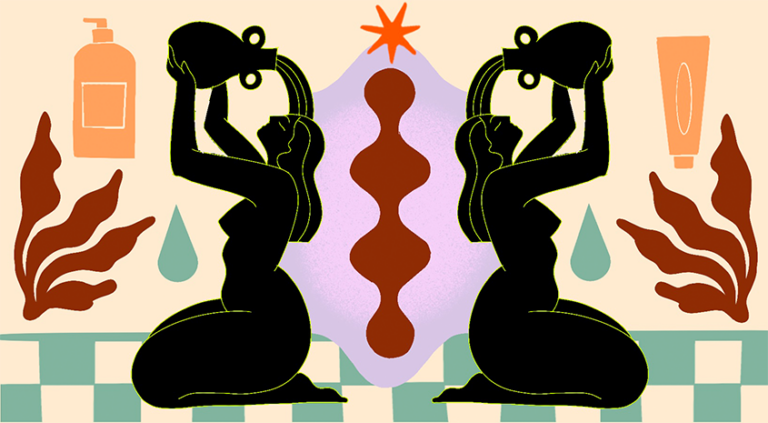The Rythm team did some extensive research and has found the reason why specific ingredients are avoided in the topical products we sell, is that they disrupt the vaginal microbiome and can be quite dangerous if not properly accounted for. Here are the ingredients we have eliminated when vetting products for our platform:
Rythm’s Encyclopedia of ‘Offbeat’ Ingredients
Benzethonium Chloride: This is a synthetic salt that can cause vaginal irritation. Studies say this is a novel cancer-specific compound, but no direct correlation was identified scientifically. It is most commonly found in vaginal creams, gels, and moisturizers.
Benzocaine: This is a local anesthetic that is used to numb the effects of vaginal infection (which it does temporarily). In the aftermath, benzocaine is considered a major vulvar irritant and can make the burning sensation worse. It is most commonly found in vaginal creams.
Butylparaben, Ethylparaben, Methylparaben, & Propylparaben: All these parabens mimic estrogen in the body and have been linked to reproductive harm, developmental harm, and breast cancer. Cyclic silicones from parabens are questionable silicones as they can cause yeast infections from use in the vaginal area.
Diazolidinyl Urea: These are well-known contact sensitizers/preservative materials; this means that it increases the longevity of the product upon contact. This is a vaginal skin irritant and can cause some redness and itching, according to studies. It is most commonly found in vaginal creams.
Dioxin & Furans: These are toxic byproducts of chlorine bleaching giving feminine care products that pristine white appearance. According to studies, if these are absorbed by the mucosa in the cervix area of the vagina, it is highly vascularized, meaning too many blood vessels. This can lead to major hormonal issues, hence it is dangerous. Dioxin and furans are most commonly found in period products like tampons and pads.
DMDM Hydantoin: Hormone disruption comes from the release of formaldehyde from this skill allergen. It is most commonly found in feminine wipes and washes.
Ethoxylated ingredients: These are skin irritants found in tampons most commonly. They can cause vaginal imbalance from formaldehyde-releasing chemicals (ex. Quaternium 15, which is also found in vaginal washes and releases such formaldehyde and includes paraben preservatives).
Glycerin: This is a sugar compound. It feeds off the bad bacteria in the vagina and causes the vaginal microbiome to be off balance. Studies have shown glycerin, found in most personal lubricants and is the biggest cause of vaginal infections and irritations.
Methylchloroisothiazolinone/Methylisothiazolinone: These can disrupt the endocrine system and cause severe allergic rashes, according to some research. This is due to unaccounted-for active ingredients. They are most commonly found in feminine washes and creams.
Mineral Oil, Paraffin, Petrolatum, and Petroleum: These are vulva irritants that break down condoms and are not safe for lubricants either. They can cause vaginal infections, STIs, and unwanted pregnancies.
Octoxynol 9: This chemical aids in forming emulsions for vaginal wipes and washes. Emulsions are mixtures of one or more liquids in which one is present in droplets. This compound can lead to urinary tract infection, inflammation, or infection of the vagina from use. Also, it is commonly found in douches.
Phthalates: This is a chemical group used to make plastics more durable. They are considered to be unexamined potential risk factors for bacterial vaginosis (BV) and warrant investigation because hormones affect BV, according to studies. These are most commonly found in tampons, sex toys, vaginal washes, and douches.
Polyethylene Glycol (PEG): Studies show this is a petroleum-based compound found in many cosmetic products for skin and hair that act as a moisturizer and/or emulsifier (ex. lube). Can also lead to BV in women and make them more susceptible to STIs like HIV.
Polyoxymethylene Urea: This is another preservative that releases formaldehyde and causes an allergic rash and potential cancers, according to studies. It is most commonly found in deodorant powders and tampons.
Propylene glycol: This is commonly used as a humectant, which means that it stops lubricants from drying out. This is important for water-based lubricants, which can evaporate in a matter of minutes if not carefully formulated. The substance is often misrepresented as a harsh industrial chemical, especially from the glycol used in lubricants. Still, it can cause vaginal irritation from use and is not safe for the reproductive tract. This all comes from the USDA source.
Synthetic Dyes, Fragrances, & Flavors: These are artificial compounds that can contain mixtures of undisclosed ingredients and cause vaginal microbiome imbalance, according to research. They disrupt natural vaginal odor and are linked to certain vaginal infections. These are most commonly found in period products, washes, deodorants, and serums.
Triclosan: Studies say this is an antimicrobial agent (kills or limits the growth of bacteria) associated with numerous effects, including endocrine disruption (disturbance to the endocrine system), vaginal skin irritation, and hormonal imbalance. It is most commonly found in douches and vaginal creams.
2-Bromo-2-Nitropropane-1, 3-Diol: Another formaldehyde-releasing preservative that causes allergic skin rash, and studies find it to also be cancerous. It is most commonly found in feminine wipes and washes.
Talcum powder: Genital talc usage may increase cervical cancer risk. Talc is generally applied to underwear, sanitary napkins, diaphragms, and/or directly to the perineal region of the vagina. Baby powder is another prime example and there is a whole study about it here. According to other prior clinical studies, the issue is that vaginal talc can travel up to the reproductive tract and cause serious damage.
Written by:
Deepshika Verma
Founder of @glambydeep & Clinical Researcher
Peer Reviewed by:
Dr. Heather Quaile, DNP, WHNP-BC, SANE, AFN-C, CSC, FAANP
Women’s & Gender Health Nurse Practitioner and AASECT Certified Sex Counselor







